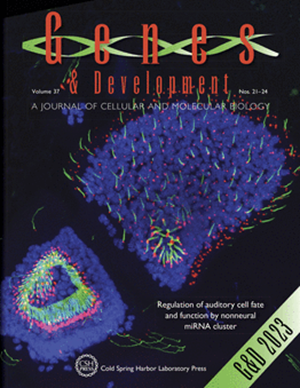多种人类增强子rna包含长翻译的开放阅读框
IF 7.7
1区 生物学
Q1 CELL BIOLOGY
引用次数: 0
摘要
增强子RNA (eRNAs)在增强子激活期间由RNA聚合酶ii转录,但通常在细胞核中迅速降解。然而,在RNA监视减少的状态下,erna和其他类似的“非编码”RNA(包括,例如,上游反义RNA)是稳定的,其中一些被输出到细胞质中,甚至可以在多聚体上找到。在这里,我们意外地报告了约12%的人类基因间erna包含长开放阅读框(>300 nt),如核糖体分析所确定的那样,其中许多可以被主动翻译,并产生积聚在细胞中的蛋白质,如质谱(MS)数据所示。将重点放在最大的编码蛋白上,我们将其命名为eorf,其可高达45 kDa,我们发现,值得注意的是,大多数是高度碱性的,pIs为11.5。这种不寻常的化学反应反映了精氨酸残基的惊人过剩,尽管赖氨酸相对缺乏。10个最大的eorf的外源表达表明,它们作为全长蛋白在细胞中稳定积累,并且大多数定位于细胞核并与染色质相关。通过质谱鉴定相互作用蛋白提示了这些蛋白在几个核过程中的可能作用。所研究的eorf在灵长类动物中保存得很好,尽管在其他哺乳动物中基本没有。值得注意的是,其中一些含有人类特有的c端扩展,并显示出提示基因新生的特性。总之,我们已经发现人类erna的一部分可以作为mrna发挥作用,揭示了这些转录物的一个新的和意想不到的作用。本文章由计算机程序翻译,如有差异,请以英文原文为准。
Multiple human enhancer RNAs contain long translated open reading frames
Enhancer RNAs (eRNAs) are transcribed by RNA polymerase IIduring enhancer activation but are typically rapidly degraded in the nucleus. During states of reduced RNA surveillance, however, eRNAs and other similar “noncoding” RNAs (including, e.g., upstream antisense RNAs) are stabilized, and some are exported to the cytoplasm and can even be found on polysomes. Here, we report unexpectedly that ∼12% of human intergenic eRNAs contain long open reading frames (>300 nt), many of which can be actively translated, as determined by ribosome profiling, and produce proteins that accumulate in cells, as shown by mass spectrometry (MS) data. Focusing on the largest of the encoded proteins, which we designated as eORFs, which can be up to ∼45 kDa, we found, remarkably, that most are highly basic, with pIs >11.5. This unusual chemistry reflects a striking overabundance of arginine residues and occurs despite a relative paucity of lysines. Exogenous expression of the 10 largest eORFs revealed that they accumulate stably in cells as full-length proteins, and most localize to the nucleus and associate with chromatin. Identification of interacting proteins by MS suggested possible roles for these proteins in several nuclear processes. The eORFs studied are well conserved among primates, though they are largely absent from other mammals. Notably, several contain human-specific C-terminal extensions and display properties suggestive of de novo gene birth. In summary, we have discovered that a fraction of human eRNAs can function as mRNAs, revealing a new and unexpected role for these transcripts.
求助全文
通过发布文献求助,成功后即可免费获取论文全文。
去求助
来源期刊

Genes & development
生物-发育生物学
CiteScore
17.50
自引率
1.90%
发文量
71
审稿时长
3-6 weeks
期刊介绍:
Genes & Development is a research journal published in association with The Genetics Society. It publishes high-quality research papers in the areas of molecular biology, molecular genetics, and related fields. The journal features various research formats including Research papers, short Research Communications, and Resource/Methodology papers.
Genes & Development has gained recognition and is considered as one of the Top Five Research Journals in the field of Molecular Biology and Genetics. It has an impressive Impact Factor of 12.89. The journal is ranked #2 among Developmental Biology research journals, #5 in Genetics and Heredity, and is among the Top 20 in Cell Biology (according to ISI Journal Citation Reports®, 2021).
 求助内容:
求助内容: 应助结果提醒方式:
应助结果提醒方式:


